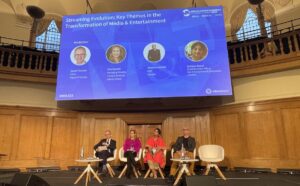
After more than 40 years of operation, DTVE is closing its doors and our website will no longer be updated daily. Thank you for all of your support.
‘Broken’ streaming model requires reset, say MELS speakers
 The “broken” streaming model is leading to a “huge devaluing of content”, execs argued at the second annual Media & Entertainment Leaders Summit (MELS) in London today.
The “broken” streaming model is leading to a “huge devaluing of content”, execs argued at the second annual Media & Entertainment Leaders Summit (MELS) in London today.
With global streamers increasingly cutting back on their content spend and moving away from the D2C model with a return to third-party sales, a panel of execs from Liberty Global, Storytel and Zee5 Global debated the future of streaming services.
Taking part in a session at Church House Westminster today, Eleni Lionaki, managing director of content ventures at multimedia company Liberty Global, said that there been an “evolution” in the business that has led to a strategy of increased content spending among streamers, and it has now become “pretty obvious that is not a sustainable business model.”
The exec highlighted how major streamers are now “rethinking their spend” and placing more focus on the “key shows that are really driving subscribers” to their platforms.
“When you’re getting into the economics of it, around the globe, subscribers are feeling the pain from different economic pressures. They’re also feeling the pain from, quite frankly, having too many subscription services.” This, she said, is leading to increased churn as audiences gravitate to specific platforms to watch specific pieces of content.
“We also need potentially different business models in terms of how you think about reducing churn, how do you think about the economics of participating in a bundle? What sort of bundle could actually deliver the same value to you – and the flipside, what sort of bundle may work for different subscribers that have different motivations?”
Fallacious notion
Joining Lionaki on the panel was Archana Anand, chief business officer at ZEE5 Global, who agreed with the Liberty exec and further suggested that the model was leading to a “huge devaluing of content.”
“[The streaming model is] is definitely broken and [this has provided] a lot of introspection. This has been the year where it’s been called out across media, where streamers have had to actually step back and rethink what we’re doing and why we’re doing it,” she said.
“I think a lot of us jumped on that bandwagon under fairly fallacious notions. It began with everybody thinking that the goal post was to boast the maximum number of subscribers. At some point you realise there’s no correlation between boasting the maximum number of subscribers and true profitability.”
Anand continued: “This fight among the streamers to get the best content to the consumer has actually led to a huge devaluing of content. So some of the best shows – Game Of Thrones, Yellowstone, Succession – are ultimately going into a streaming bundle, and the math is not making sense.
“You can take all the subscribers into the maximum ARPU, and that is still no correlation to the time, energy, effort or money that went into making any of these iconic shows.”
Capital market environment
One dissenting voice on the panel was CEO of Storytel and former HBO Max international chief, Johannes Larcher, who said that the streaming model was “certainly not broken”. Pointing to Netflix as an “incredibly profitable business” he said that such success required scale and a disciplined content spend.
“But to get to that scale of subscribers requires incredible amounts of capital, and what has changed in the market over the last two years is the access to capital money is no longer free and capital markets have changed expectations of what they demand from new businesses.”
Larcher continued: “So I don’t think anything is fundamentally broken. The question is, how can you survive in the current capital market environment and how can you ultimately get to the benefits of global scale that you will need to run this? If you can’t do it alone, then the question comes, how do I leverage others?”
Responding to Larcher, Anand suggested “that’s the whole problem” as only “one, two, three” players on the global stage may now be able to achieve the same scale as he was outlining.


